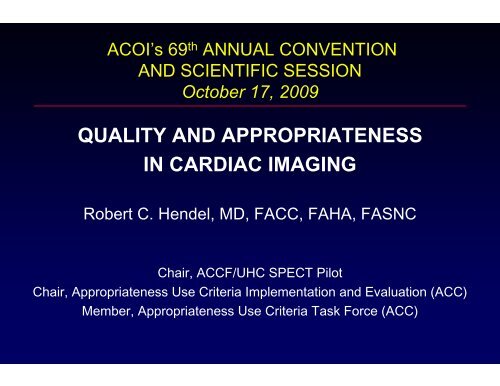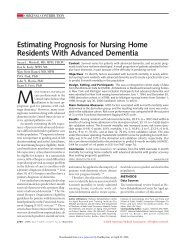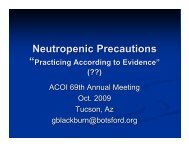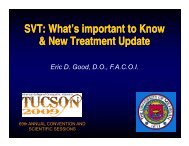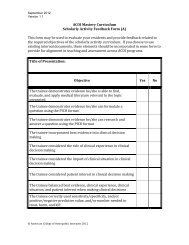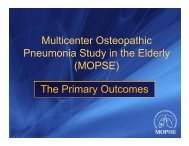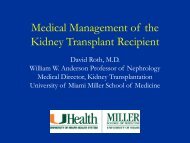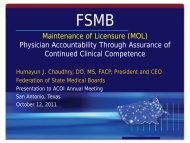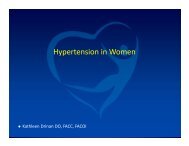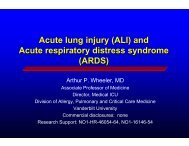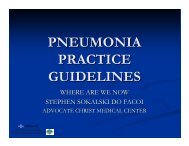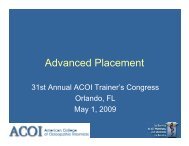QUALITY AND APPROPRIATENESS IN CARDIAC IMAGING
QUALITY AND APPROPRIATENESS IN CARDIAC IMAGING
QUALITY AND APPROPRIATENESS IN CARDIAC IMAGING
Create successful ePaper yourself
Turn your PDF publications into a flip-book with our unique Google optimized e-Paper software.
ACOI’s 69 th ANNUAL CONVENTION<br />
<strong>AND</strong> SCIENTIFIC SESSION<br />
October 17, 2009<br />
<strong>QUALITY</strong> <strong>AND</strong> <strong>APPROPRIATENESS</strong><br />
<strong>IN</strong> <strong>CARDIAC</strong> IMAG<strong>IN</strong>G<br />
Robert C. Hendel, MD, FACC, FAHA, FASNC<br />
Chair, ACCF/UHC SPECT Pilot<br />
Chair, Appropriateness Use Criteria Implementation and Evaluation (ACC)<br />
Member, Appropriateness Use Criteria Task Force (ACC)
Presenter Disclosure Information<br />
Robert C. Hendel, MD<br />
The following relationships exist related to this presentation:<br />
Consulting PGx Health Modest<br />
Astellas Pharma<br />
Modest<br />
Speakers’ Bureau Astellas Pharma Modest<br />
Research support Astellas Modest<br />
GE Healthcare<br />
Modest<br />
Organizational<br />
ACC (Appropriate Use Criteria Task Force, others)<br />
ICANL (Board of Directors)
FOCUS ON MEDICAL IMAG<strong>IN</strong>G<br />
MEDPAC Evaluation of Physician Services<br />
%<br />
45<br />
40<br />
35<br />
30<br />
25<br />
20<br />
15<br />
10<br />
5<br />
0<br />
Major<br />
Procedures<br />
Growth of All<br />
Physician Services<br />
Other<br />
Procedures<br />
Includes all Services in the Physician Fee Schedule<br />
Source: MEDPAC Analysis of Medicare Claims Data<br />
March 17, 2005, Executive Director, Medicare Payment Advisory Commission, Mark Miller,.htm<br />
Imaging<br />
22%
MEDICARE PAYMENT ADVISORY COMMISSION (MEDPAC)<br />
EVALUATION OF THE GROWTH <strong>IN</strong> PHYSICIAN SERVICES<br />
2000-2004 <strong>AND</strong> 2004-2005<br />
Average Annual Growth, %<br />
eport to Congress, Medicare Payment Advisory Commission<br />
hysician Services, March, 2007<br />
Hendel RC, 2008<br />
JACC-Imaging 1: 241.
GEOGRAPHIC VARIATIONS <strong>IN</strong> IMAG<strong>IN</strong>G<br />
STRESS TEST<strong>IN</strong>G PROCEDURE RATES<br />
• Up to 8-fold variation<br />
• Often not risk-adjusted (GAO)<br />
Wennberg, D. The Dartmouth Atlas of Cardiovascular Health Care 1999: 60-61
THE “CASE” FOR SELF-REFERRAL<br />
SPECT MYOCARDIAL PERFUSION IMAG<strong>IN</strong>G UTILIZATION<br />
RADIOLOGISTS & CARDIOLOGISTS, MEDICARE 1998-2006<br />
+159%<br />
exams/1000<br />
cardiologists<br />
radiologists<br />
-8%<br />
*’98-’02 data in Levin DC, Intenzo CM, Rao VM et al, JACR 2005; 2: 821
THE <strong>IN</strong>CREASE OF <strong>IN</strong>-OFFICE IMAG<strong>IN</strong>G<br />
Factors Beyond Self-Referral<br />
• Technological advances<br />
• Expanded applications<br />
• “True” expertise<br />
• Avoidance of “other” methods<br />
• Patient-centered (demand)<br />
• Fear of litigation
<strong>CARDIAC</strong> IMAG<strong>IN</strong>G 2009<br />
• Patients deserve (and demand) the highest level quality<br />
of health care, including ready access to imaging<br />
• Providing imaging within specialities and practices does<br />
not make it “bad” by definition<br />
–Allows for clinical integration<br />
–May allow for earlier, less invasive, more accurate diagnosis<br />
–Quality is critical, irrespective of location
UTILIZATION MANAGEMENT<br />
FOR <strong>CARDIAC</strong> IMAG<strong>IN</strong>G<br />
METHODS<br />
• Non-coverage<br />
• Privileging (exclusion)<br />
• Profiling<br />
• Prior notification<br />
• Pre-certification<br />
(prior authorization)<br />
RBM<br />
(RADIOLOGY BENEFITS MANAGERS)<br />
• Procedural governors<br />
• Increasing penetration<br />
• Focus on ordering clinician,<br />
often PCP<br />
• Incentivized to reduce<br />
volume/cost
CONCERNS REGARD<strong>IN</strong>G PRE-CERTIFICATION<br />
<strong>AND</strong> PRIOR NOTIFICATION<br />
Hendel RC, 2008<br />
JACC-Imaging 1: 241-8<br />
• No evidence for improved quality of care<br />
• Favors indiscriminant volume reduction<br />
• Lack of transparency<br />
• Not firmly based on appropriateness criteria<br />
• Inconsistent processes, with confusion and inefficiency<br />
• Reduced timeliness<br />
• Labor intensive<br />
• Negative economic impact<br />
• Steerage to the test of least resistance<br />
• Scant data available for feedback/education<br />
• No opportunity to refine process<br />
• No correlation with imaging results or outcome<br />
• No mechanism to understand practice variation or local expertise
WHY <strong>APPROPRIATENESS</strong><br />
Background<br />
• Unprecedented focus on<br />
assessment and improving quality<br />
• Explosive growth of CV imaging<br />
• Substantial regional variation<br />
• True nature of utilization unknown<br />
–Overuse/ Underuse/Appropriate<br />
• Clinicians, patients, and especially<br />
payers seeking guidance
PROOF OF VALUE OF IMAG<strong>IN</strong>G <strong>AND</strong> RBM’s<br />
• “We are not aware of any peer-review studies that conclusively<br />
show the role of imaging in reducing overall health care costs”<br />
–GAO, 2008<br />
• “I am not aware of any studies that conclusively show the role<br />
of RBM’s in reducing overall health costs or improving quality<br />
–R. Hendel, 2009
PHYSICIAN RESPONSES TO<br />
MEDICAL IMAG<strong>IN</strong>G “CRISIS”<br />
Individual Practicioner<br />
Ignorance of problem<br />
Medicolegal fears<br />
Arrogance<br />
Gratuitous practice<br />
Economic incentive
ORGANIZATIONAL RESPONSES TO<br />
MEDICAL IMAG<strong>IN</strong>G “CRISIS”<br />
ASNC, ACC and Subspecialty Organizations<br />
• Think Tank meetings on image quality<br />
• Support of accreditation<br />
• Establishment of policy on self-referral<br />
• Focus on quality and access<br />
• Development of AUC<br />
• Development of alternatives to RBM,<br />
including point-of-service decision<br />
support tools.
CONT<strong>IN</strong>UED EMPHASIS ON<br />
<strong>QUALITY</strong> <strong>IN</strong> IMAG<strong>IN</strong>G<br />
Patient<br />
Test<br />
selection<br />
Appropriateness criteria<br />
Provider education<br />
Image<br />
acquisition<br />
Lab accreditation<br />
Certification<br />
Image<br />
interpretation<br />
Accuracy<br />
Reprodicibility<br />
Physician competency<br />
Results<br />
communication<br />
Key data elements<br />
Uniform structured reports<br />
Timeliness standards<br />
Better<br />
patient<br />
care<br />
Registries<br />
Research<br />
Outcomes,<br />
Value<br />
ACC-Duke Think Tank 2006<br />
JACC 2006 48: 214
M<strong>AND</strong>ATORY IMAG<strong>IN</strong>G<br />
LABORATORY ACCREDITATION<br />
• Endorsed by ACC and subspecialty organizations (ASNC, ASE)<br />
• Provided by ACR or ICA (Intersocietal<br />
Accreditation Commission)<br />
–ICAVL, ICANL, ICAEL, ICAMRL, ICACTL<br />
• United Healthcare and other require accreditation<br />
–CT and CTA<br />
–CMR and MRA<br />
–Nuclear cardiology<br />
–PET<br />
–Echocardiography<br />
• CMS to require lab accreditation by 2012
ICANL<br />
Intersocietal Commission for<br />
the Accreditation of Nuclear<br />
Medicine Laboratories<br />
ICACTL<br />
Intersocietal Commission for the<br />
Accreditation of Computed<br />
Tomography Laboratories<br />
• 1,719 accredited labs, 2,406 sites<br />
(8/25/09)<br />
• Sponsored by ASNC, ACC, SNM,<br />
SNM-TS, AMI, ACNP<br />
• Substantial QA review, sample reports<br />
• Site visits now selective<br />
• 33% re-accreditation applications<br />
• Ensures quality<br />
• Basis for reimbursement<br />
Payers often now requiring accreditation<br />
Accreditation mandated by ACC and ASNC<br />
• 45 accredited lab/sites for CCS, CCTA<br />
• Sponsoring organizations:<br />
– American Academy of Neurology<br />
– American Academy of Otolaryngology<br />
– American Association of Physicists in Medicine<br />
– American College of Cardiology<br />
– American Society of Echocardiography<br />
– American Society of Nuclear Cardiology<br />
– Society for Cardiovascular Angiography and Interventions<br />
– Society for Vascular Surgery<br />
– Society of Cardiovascular Computed Tomography<br />
– Society of Nuclear Medicine<br />
• Substantial QA review, sample reports,<br />
representative cases
• NRC recognized pathway for AU Status<br />
• Sponsoring organizations<br />
-American College of Cardiology<br />
-American Society of Nuclear Cardiology<br />
• First exam, September 7, 1996<br />
• 6,508 diplomates (as of 8/26/09)<br />
• www.cbnc.org<br />
• Sponsoring organizations<br />
–American College of Cardiology<br />
–American Society of Nuclear Cardiology<br />
–Society of Cardiovascular Angiography and<br />
Interventions<br />
–Society of Cardiovascular Computed<br />
Tomography<br />
• First exam, September 22, 2008<br />
• The mission of the Certification Board of<br />
Cardiovascular Computed Tomography (CBCCT)<br />
is to promote and enhance patient care by defining<br />
the domain of cardiovascular computed<br />
tomography and identifying the requisite<br />
knowledge and skills for quality practice through a<br />
certification program that fosters excellence and<br />
encourages continual learning.<br />
• 731 diplomates (as of 8/26/09)<br />
• www.cbcct.org
GUIDEL<strong>IN</strong>ES, MEASURES, <strong>AND</strong><br />
<strong>APPROPRIATENESS</strong> CRITERIA<br />
• Clinical Guidelines 1<br />
–Exhaustive review of literature<br />
–Virtually all-inclusive<br />
–Best practice<br />
–“Should do, should not do”<br />
• Performance Measures 2<br />
–Selective, focused, measurable<br />
–Based on guidelines<br />
–“Must do”<br />
–Tools for quality measurement<br />
• Appropriateness Criteria 3<br />
–Selective indications<br />
–Largely guideline based<br />
–Clinical scenarios<br />
–“Reasonable to do”<br />
1. Klocke FJ, Baird MG, Lorell BH, et al.<br />
ACC/AHA/ASNC guidelines for the clinical use of<br />
cardiac radionuclide imaging. Circulation 2003; 106:<br />
1883-92<br />
2. Krumholtz HM, Anderson JL, Brooks, et al.<br />
ACC/AHA clinical performance measures for adults with<br />
ST-elevation and non-ST-elevation myocardial<br />
infarction. J Am Coll Cardiol 2006; 47: 236-65.<br />
3. Hendel RC, Berman DS, Di Carli M Fet al.<br />
ACCF/ASNC appropriateness use criteria for cardiac<br />
radionuclide imaging. J Am Coll Cardiol 2009; 53: 2201-<br />
29.
ACCF <strong>APPROPRIATENESS</strong> USE CRITERIA<br />
• Literature-based (when possible) approach to improve utilization<br />
of resource-intensive tests and procedures<br />
–Developed by physicians/providers<br />
–Initial focus on cardiac imaging<br />
–Expansion to revascularization, potential for other procedures<br />
• Serves as a method for focused reduction of procedures based<br />
on clinical value, not indiscriminant volume reduction<br />
• Keeps money within the system and permits continuous quality<br />
improvement though education<br />
• Preserves patient/provider relationship<br />
• Provides for continued patient access
APPROPRIATE USE CRITERIA<br />
The ACC Queue<br />
√ Nuclear cardiology (SPECT)<br />
October, 2005<br />
√ Cardiac CT/CMR<br />
September, 2006<br />
√ Echocardiography (TTE, TEE)<br />
July, 2007<br />
√ Echocardiography (Stress)<br />
December, 2007<br />
Percutaneous coronary intervention<br />
December, 2008<br />
Revised radionuclide imaging criteria (5/16/09)<br />
• CV imaging cross modality (efficiency) evaluation<br />
• Revised CT criteria
WHAT IS AN APPROPRIATE IMAG<strong>IN</strong>G STUDY<br />
An appropriate imaging study is one in which the expected<br />
incremental information, combined with clinical judgment,<br />
exceeds the expected negative consequences* by a<br />
sufficiently wide margin for a specific indication that the<br />
procedure is generally considered acceptable care and a<br />
reasonable approach for the indication.<br />
*Negative consequences include the risks of the procedure (i.e.,<br />
radiation or contrast exposure) and the downstream impact of<br />
poor test performance such as delay in diagnosis (false<br />
negatives) or inappropriate diagnosis (false positives).
APPROPRIATE USE CRITERIA US<strong>IN</strong>G THE<br />
R<strong>AND</strong>/DELPHI METHODOLOGY<br />
Writing Group<br />
Literature Review and Synthesis of the Evidence<br />
List of indications and definitions<br />
External Reviewers<br />
Technical Panel<br />
Implementation<br />
Working Group<br />
Validation Appropriateness Determination<br />
Outside Review of Indications and Additional Modification Prior to Rating<br />
Balanced panel comprised of different types of experts rates the indications in two rounds<br />
1 st Round – No interaction<br />
Face-to-Face Meeting<br />
2 nd Round – Panel interaction<br />
Appropriateness Score<br />
(7-9) Appropriate<br />
(4-6) Possibly Appropriate/Uncertain<br />
(1-3) Inappropriate<br />
Retrospective comparison with clinical records<br />
Prospective clinical decision aids<br />
% Use that is Appropriate, Uncertain, Inappropriate Increase Appropriateness<br />
dapted from Fitch K, et al. The R<strong>AND</strong>/UCLA Appropriateness Method User’s Manual, 2001, 4
ACCF/ACEP/ACR/AHA/ASE/ASNC/SCCT/ SCMR/SNM<br />
2009 Appropriate Use Criteria for<br />
Cardiac Radionuclide Imaging<br />
A Report of the American College of Cardiology Foundation Appropriate Use Criteria Task<br />
Force, the American College of Emergency Physicians, the American College of Radiology,<br />
the American Heart Association, the American Society of Echocardiography, the American<br />
Society of Nuclear Cardiology, the Society of Cardiovascular Computed Tomography, the<br />
Society of Cardiovascular Magnetic Resonance, and the Society of Nuclear Medicine<br />
<strong>CARDIAC</strong> RADIONUCLIDE IMAG<strong>IN</strong>G WRIT<strong>IN</strong>G GROUP<br />
Robert C. Hendel, MD, FACC, FAHA, FASNC, Chair<br />
Daniel S. Berman, MD, FACC, FCCT<br />
Marcelo F. Di Carli, MD, FACC, FSNM<br />
Paul A. Heidenreich, MD, FACC<br />
Robert E. Henkin, MD, FACR<br />
Patricia A. Pellikka, MD, FACC, FASE<br />
Gerald M. Pohost, MD, FACC, FSCMR<br />
Kim A. Williams, MD, FACC, FAHA<br />
J Am Coll Cardiol, 2009; 53:2201-2229
KEY DEF<strong>IN</strong>ITION<br />
ISCHEMIC EQUIVALENT:<br />
Chest Pain Syndrome, Anginal Equivalent, or Ischemic<br />
ECG abnormalities: Any constellation of clinical findings<br />
that the physician feels is consistent with obstructive coronary<br />
artery disease. Examples of such findings include, but are not<br />
exclusive to, chest pain, chest tightness, burning, shoulder<br />
pain, palpitations, jaw pain, and new ECG abnormalities<br />
suggestive of ischemic heart disease. Non-chest pain<br />
symptoms, such as dyspnea or worsening effort tolerance that<br />
are felt to be consistent with CAD may also be considered to<br />
be an anginal equivalent.
<strong>APPROPRIATENESS</strong> USE CRITERIA FOR<br />
RADIONUCLIDE CARDIOVASCULAR IMAG<strong>IN</strong>G<br />
Clinical Stratification (1)<br />
Age Gender<br />
Typical/Definite Atypical/Probable Nonanginal<br />
Angina Pectoris Angina Pectoris Chest Pain<br />
Asymptomatic<br />
< 39<br />
Men Intermediate Intermediate Low Very low<br />
Women Intermediate Very low Very low Very low<br />
40 Š Men High Intermediate Intermediate Low<br />
49 Women Intermediate Low Very low Very low<br />
50 - 59<br />
Men High Intermediate Intermediate Low<br />
Women Intermediate Intermediate Low Very low<br />
> 60<br />
Men High Intermediate Intermediate Low<br />
Women High Intermediate Intermediate Low<br />
PRE-TEST PROBABILITY OF CAD<br />
Diamond, GA, Forrester JS<br />
NEJM 1979; 300: 1350-8<br />
Adapted from ACC/AHA Exercise Testing<br />
Guidelines Gibbons et al, 2002<br />
Available www.acc.org.<br />
Modified for AUC RNI (Hendel et al, 2009)<br />
CORONARY HEART DISEASE RISK<br />
Adapted from 3rd Report of the NCEP Panel<br />
Adut Treatment Panel III (ATP III)<br />
ACC/AHA Scientific Statement:<br />
NIH Publication No. 02-5215<br />
www.nhlbi.nih..gov<br />
Low: 10-year absolute CHD risk 20%<br />
Risk relates to “hard event”
HIERARCHY OF POTENTIAL TEST<br />
ORDER<strong>IN</strong>G FOR AUC DETERM<strong>IN</strong>ATION<br />
Pre-op<br />
NO<br />
w/i 3 mo ACS<br />
NO<br />
Prior Revasc<br />
NO<br />
Prior Imaging<br />
NO<br />
Ischemic equivalent<br />
NO<br />
Asymptomatic<br />
YES<br />
YES<br />
YES<br />
YES<br />
YES<br />
YES<br />
Table 4<br />
Figure 5<br />
Table 5<br />
Table 6<br />
Figure 6<br />
Table 3<br />
Figure 4<br />
Table 1<br />
Figure 2<br />
Table 3<br />
Figure 3
APPROPRIATE USE OF RNI<br />
Evaluation of Suspected CAD<br />
Symptomatic, chronic<br />
Ischemic equivalent<br />
Low Probability<br />
Intermediate Probability<br />
High Probability<br />
ECG Interp <strong>AND</strong><br />
Able to exercise<br />
ECG uninterp OR<br />
Unable to exericse<br />
APPROPRIATE<br />
APPROPRIATE<br />
<strong>IN</strong>APPROPRIATE<br />
APPROPRIATE<br />
Possible ACS<br />
ECG w/o ischemic ∆’s, or with LBBB, pacer<br />
Normal or low-level troponin elevation<br />
Low or high risk TIMI scores
APPROPRIATE USE OF MPI-REVISED AUC<br />
Perioperative Evaluation for Elective Noncardiac Surgery<br />
RISK FACTORS<br />
• History of CAD<br />
• History of HF<br />
• Cerebrovasc. disease<br />
• Insulin-requiring DM<br />
*<br />
• Renal insufficiency<br />
* Inappropriate if asymptomatic up to 1 year s/p normal<br />
angiogram, non-invasive test of previous revascularization
<strong>APPROPRIATENESS</strong> OF CARDIOVASCULAR IMAG<strong>IN</strong>G<br />
Potential Impact of Appropriateness Criteria<br />
• Establishment of partnership among clinicians,<br />
educators, and payers regarding rational practices in<br />
cardiovascular imaging and fair reimbursement<br />
• Education of clinicians regarding their practice habits<br />
• Emphasis of clinical indications to drive testing<br />
• Facilitate reimbursement for “appropriate” and<br />
“uncertain” indications<br />
• Support for requirement of preauthorization or denial<br />
of reimbursement for “inappropriate” indications<br />
• Improve cost-effectiveness of cardiovascular imaging
<strong>APPROPRIATENESS</strong> USE CRITERIA<br />
Concerns and Limitations<br />
• Appropriateness criteria are NOT substitutes for sound<br />
clinical judgment and practice experience<br />
• Should NOT be used to provide information regarding<br />
the technical aspects of imaging nor delineate<br />
training/performance requirements<br />
• Imperfect product<br />
–Indications not inclusive but also too specific<br />
–May differ from guidelines<br />
–Difficult to use, but logistics improving
APPROPRIATE USE CRITERIA<br />
Implementation and Evaluation<br />
• Integration within practice workflow<br />
–Point-of-service<br />
–Point-of-order<br />
• Logistics<br />
–Requisitions<br />
–Web tools<br />
–POE/EMR<br />
• Must preserve physician autonomy and flexibility
Hendel RC et al<br />
ACC, 2009<br />
ACCF/UNITEDHEALTHCARE SPECT PILOT<br />
Appropriateness Classification (n = 5,928)
EVALUATION OF <strong>APPROPRIATENESS</strong><br />
Appropriate Uncertain Inappropriate<br />
Hendel, 2006 83% 6% 11%<br />
Mehta, 2006 78% 5% 8%<br />
Ayyad, 2007 85% 5% 10%<br />
Druz, 2007 57% 33% 10%<br />
Gaztanega, 2007 55% 28% 17%<br />
Al-Mallah, 2007 75% 12% 13%<br />
Gibbons, 2008 64% 11% 14%<br />
Hendel, 2009 71% 15% 14%
ACCF/UNITEDHEALTHCARE SPECT PILOT<br />
Most Common “Inappropriate” Indications<br />
<strong>IN</strong>DICATION<br />
% <strong>IN</strong>APPRO<br />
<strong>IN</strong>DICATIONS<br />
% TOTAL<br />
STUDIES<br />
Detection of CAD<br />
Asymptomatic, low CHD risk 44.5% 6.0%<br />
Asymptomatic, post-revascularization<br />
< 2 years after PCI, symptoms before PCI 23.8% 3.2%<br />
Evaluation of chest pain, low probability pt<br />
Interpretable ECG and able to exercise 16.1% 2.2%<br />
Asymptomatic or stable symptoms, known CAD<br />
< 1 year after cath or abnormal prior SPECT 3.9% 0.5%<br />
Pre-operative assessment<br />
Low risk surgery 3.8% 0.5 %<br />
TOTAL 92.1% 12.4 %
<strong>APPROPRIATENESS</strong> CATEGORY<br />
Based on Referral<br />
p < 0.0001<br />
13.2%<br />
16.1%<br />
19.5%<br />
9.9%<br />
70.7% 70.7%<br />
Hendel RC et al<br />
ACC, 2009<br />
n = 4,792 n = 1,136
APPROPRIATE USE CRITERIA<br />
Educational Initiatives<br />
• Target inappropriate indications<br />
–Determine most common inappropriate indications<br />
–Pocket cards, explanatory information<br />
• Joint attribution<br />
–Ordering and performing/interpreting physicians<br />
–Provide sample letter to practices for education on ordering patterns and<br />
focused discouragement of key inappropriate indications<br />
• Improvement in ordering patterns<br />
–PDA and web-based tools to provide immediate feedback<br />
–Interim reports to practices<br />
–Establishment of inappropriate “threshold”<br />
–Order entry and decision support tools<br />
–Threshold values or percent reduction of inappropriate exams
CHANG<strong>IN</strong>G PATTERNS OF <strong>APPROPRIATENESS</strong><br />
Impact of Education (n=862)<br />
2006 2007<br />
Ayyad et al<br />
AHA 2007
AUC: IMPLEMENTATION <strong>AND</strong> EVALUATION<br />
New Technology<br />
• Migration towards point-of-order<br />
• Embedded clinical decision support<br />
• Tracking/data registry<br />
• Reporting/feedback
APPROPRIATE USE CRITERIA<br />
Potential Impact on Physician<br />
• Education regarding practice habits<br />
• Emphasize clinical indications to drive testing<br />
• Documentation of quality metric<br />
• Facilitation of reimbursement<br />
• Recognition that rate of inappropriate testing is not<br />
zero, nor should it be<br />
• Avoidance of RBM
WHITE HOUSE SUMMIT ON HEALTH CARE<br />
March 5, 2009<br />
“With the support of Congress and others, the ACC is<br />
willing to commit to reducing the rate of inappropriate<br />
cardiovascular imaging by 15 percent in the first year<br />
through the use of physician created appropriate use<br />
criteria…[to] reduce the financial burden of our health<br />
care system.”<br />
W. Douglas Weaver, MD<br />
President, ACC
<strong>QUALITY</strong> ISSUES IMPACT<strong>IN</strong>G PRACTICE<br />
Conclusions<br />
• Utilization management of cardiac imaging will continue<br />
–Self-regulation is a large and bitter “pill to swallow”<br />
• Most physicians are not knowingly ordering inappropriate tests or<br />
self-referring for economic reasons<br />
–Physicians must take responsibility for all aspects of cardiac imaging,<br />
including utilization<br />
–Must be joint effort by physicians, policymakers and patients<br />
• Practices must begin/continue quality improvement processes<br />
• AUC, accreditation, and other quality metrics should serve as the<br />
foundation for utilization strategies<br />
–AUC, CPG, PM have been developed to provide guidance, but their<br />
implementation and evaluation are key to improving performance<br />
–These provide alternatives to more onerous utilization management<br />
strategies, including prior authorization


